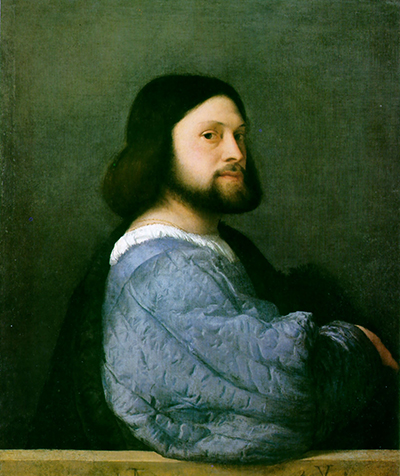Titian's Portrait of Ariosto is, at first superficial glance, a snapshot-style portrait of a man who is glancing, side-eye, at the viewer.
The subject is thought to be a poet called Ariosto – hence the name – but of late experts have begun to doubt this. When doubts first arose, it was assumed that the painting was perhaps a self-portrait (maybe because Rembrandt was a fan of the pose and used it himself in not one but two of his own self renderings, having seen the picture on display in the Netherlands before it was transported to England), but this has also been dismissed. The National Gallery, the current possessors of the painting, have tentatively called the painting Portrait of Geralamo Barbarigo, but it has also been called Portrait of a Man, Man with Blue Sleeve and even, A Man with a Quilted Sleeve.
So much for nomenclature. In the portrait, Titian's genius is readily seen. As stated above the image seems to be almost unposed, but closer analysis unpacks so much more from this painting. The man's right eye, the one closer to the viewer, is precisely centred on the vertical axis of the painting, and it is around one third of the way from the top of the painting – showing that it follows the rule of three which dictates some of the niceties of composition – while the ornate and exquisitely rendered sleeve occupies much of the lower part of the canvas, drawing the eye almost more than the man's face. The curve of the arm, starting near the hand and wrist and curving up along the shoulder and around the face comprise an almost perfect golden spiral that circles ever more tightly into that centrally placed eye. It is this attention to placement that makes the portrait such a compelling image.
Unusually for Titian's work, this man is clearly stationary: the artist often manages to capture his subjects in the midst of apparently fast movements. A shrug, demonstrations of high emotion, even characters walking, running and falling; these are all captured in precise detail which must have taken many hours of painstaking work but which look as though Titian had raised a camera and snapped the moment at precisely the right instant to create a memorable work of art. As stated above, it is the detailing of the sleeve along with the mathematical precision of the layout that makes this portrait stand out. So carefully did Titian paint the fabric that the viewer almost feels tempted to stretch out a hand to feel if the sleeve is as thick and soft and shiny as the paint has made it appear!
The man's arm rests on – and slightly over, in natural fashion – a wooden sill. This is a device commonly in use at the time to justify the breaking off of a portrait without depicting the legs and feet of the subject. Here too, Titian has applied his genius for accuracy, painting the plain wood with such skill that one wonders whether the sitter got any splinters in his hand!




